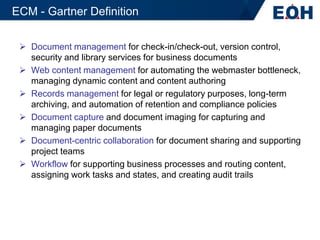EOH ECM Offering
- 2. ECM - Gartner Definition ï Document management for check-in/check-out, version control, security and library services for business documents ï Web content management for automating the webmaster bottleneck, managing dynamic content and content authoring ï Records management for legal or regulatory purposes, long-term archiving, and automation of retention and compliance policies ï Document capture and document imaging for capturing and managing paper documents ï Document-centric collaboration for document sharing and supporting project teams ï Workflow for supporting business processes and routing content, assigning work tasks and states, and creating audit trails
- 3. Simply PutâĶ ï Enterprise Content Management is about: ï People ï âAuthors, Readers, Approvers ï âAuthorizations & access ï âDocument-centric collaboration ï Information ï âDocuments & content ï âMetadata & attributes ï âConsolidation & harmonization ï Processes ï âWorkflows ï âRetention rules ï âDocument lifecycle
- 4. Business Requirements ï Legislative and Audit Purposes ï Exert Control over an abundance of records and documents ï Need to automate Business Process ï Assist with the authoring and publishing of information
- 5. SAP ECM
- 6. Open Text for SAP
- 7. EOH SAP Services Strategy, Analysis & Tool Assessment Goals, Design Implementation Maintenance Selection Direction
- 8. Thank you







